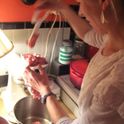I hear wine slushies are having a moment. And I don’t mean I have cleverly determined this via observation and sniffing out trends. Rather, over the last week, I have received in my inbox (which gets filled with food and beverage newsletters and email blasts of all sorts) at least three different newsletters that contained the sentence, “wine slushies are having a moment.” And that’s not counting the other emails I received that ecstatically proclaimed the merit of the “frosé,” which, as far as I’ve researched it, seems to be a special term reserved for wine slushies made with rosé.
In a world where rosé gets its own nail polish colors, and one of the best things you can do to relax with friends is share a bottle of wine, and where coffee and tea and fruits and vegetables are all being blended with ice, I’m not at all surprised that wine is now getting the slushie/smoothie/Frappuccino treatment. But what may be surprising, at least to some, is that this idea is actually far from new. So far from new, in fact, as to be dateable back to the early to mid-1800s.
But, in those days it was called a cobbler.
Per cocktail historian David Wondrich’s research, Harry Johnson, in his 1888 edition of the Bartender’s Manual, claims that the sherry cobbler was “without doubt the most popular beverage in the country, with ladies as well as with gentleman.” And its popularity extended beyond the borders of the United States to Central America, Europe, and even Australia. The cobbler was a mixture of wine or a fortified wine like sherry—the sherry cobbler being the most popular of all the varieties—with fruit and sugar, poured over large amounts of crushed or shaved ice. Doesn’t that sound like a wine slushie to you? Except it’s classier, because history.
The sherry (or wine) cobbler’s name may have the same namesake as the baked cobbler (though the two are otherwise unrelated). That is to say, the crushed ice looked like cobblestones to historical eyes, and therefore the drink was called a cobbler (in the baked fruit dessert, the pieces of dough are also said to look like cobblestones).
And that brings to the fore an interesting artifact of history, which is that the popularity of the cobbler arose at the same time as the ice trade. America’s newfound ice fetish allowed the sherry cobbler to flourish (sherry and sugar without copious amounts of ice is an unremarkable drink). In turn, the immense popularity of sherry cobblers allowed a newfangled little invention called the drinking straw to make its way into common use. And brain freeze was never the same again. If that’s not a cool (literally) series of events, I don’t know what is.
I recommend a medium dry sherry for making a sherry cobbler, like an Amontillado or maybe Manzanilla. If using wine, a sweet white wine like a Muscat, or an off-dry to sweet Riesling, is good. You can also certainly make a cobbler with a rosé or even a full-bodied red wine. Just make sure to adjust the amount of sugar you’re using based on how sweet or dry your wine is. For medium dry, I like to use about 2 teaspoons sugar. Stir until this dissolves in the wine or sherry, then add a slice of orange or three and some berries, apricot or peach slices, or tropical fruit slices—whatever you think will highlight the flavors in your wine. Shake with ice until cold and the fruit is essentially muddled, then strain into a glass filled with crushed or shaved ice and garnish with some more pieces of fruit. Serve with a straw, and slushie like it’s 1889. As they say, what’s old is new again.
| 4 | ounces medium dry sherry such as Amontillado |
| 2 | teaspoons sugar (preferably super fine) |
| 2 to 3 | orange slices |
| Crushed (or shaved) ice and berries or orange slices for serving |
| 4 | ounces medium dry sherry such as Amontillado |
| 2 | teaspoons sugar (preferably super fine) |
| 2 to 3 | orange slices |
| Crushed (or shaved) ice and berries or orange slices for serving |
Fiveandspice, a.k.a. Emily Vikre, is a writer, self-described "food policy wonk," and co-founder of Vikre Distillery. She lives in Duluth, Minnesota. You can read more of her writing here.
Boom! What other cocktails will you be slushie-ing this summer? Give us some good ideas in the comments.





See what other Food52 readers are saying.